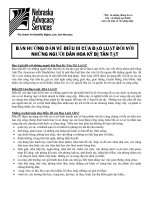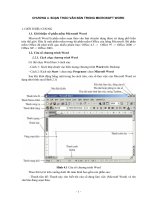microsoft word akforex trading tips pptx
Bạn đang xem bản rút gọn của tài liệu. Xem và tải ngay bản đầy đủ của tài liệu tại đây (151.9 KB, 38 trang )
www.akforex.com
TRADING TIPS133
1. Learn the basics of forex trading.
It's amazing how many people simply
don't know what they're doing. In order to
compete at the highest level in the trading
business and be one of the few truly
successful participants you must be well-
educated about what you are doing. This
does not mean having a degree from a
well-respected university – the market
doesn’t care where you were educated.
2. Forex trading is a zero sum game.
For every long there is also a short. If
80% of the traders are on the long side
,then the remaining 20% are on the short
side. This means further that the shorts
must be well capitalized and are
considered to be strong hands. The 80%,
who are holding much smaller positions
per trader, are considered to be weaker
hands who will be forced to liquidate
those longs on any sudden turn in prices.
3. Nobody is bigger than the market.
4. The challenge is not to be the market,
but to read the market. Riding the wave is
much more rewarding than being hit by it.
5. Trade with the trends, rather than trying
to pick tops and bottoms.
6. Trying to pick tops and bottoms is
another common fx trading mistake. If
you're going to trade tops and bottoms, at
least wait until the price action actually
confirms that a top or a bottom has been
formed before you take a position in the
market. Trying to pin-point tops and
bottoms in the foreign exchange market is
very risky, but exercising a little patience
and waiting for a proven top or bottom to
form can increase your odds of profiting
and somewhat reduce your risk.
7. There are at least three types of
markets: up trending, range bound, and
down. Have different trading strategies for
each.
8. Standing aside is a position.
9. In uptrends, buy the dips ;in
downtrends, sell bounces.
10. In a Bull market, never sell a dull
market, in Bear market, never buy a dull
market. www.akforex.com.
11. Up market and down market
patterns are ALWAYS present, merely
one is more dominant. In an up market, for
example, it is very easy to take sell signal
after sell signal, only to be stopped out
time and again. Select trades with the
trend.
12. A buy signal that fails is a sell signal.
A sell signal that fails is a buy signal.
13. Let profits run, cut losses short.
14. Let your profits run, but don't let
greed get in the way. Once you've already
made a nice profit on a trade, consider
taking either some or all of the money off
the table and move on to the next trade. It's
natural to hope that one trade will end up
as your "winning lottery ticket" and make
you rich, but that is simply not realistic.
Don't hold the position too long and end
up giving all your well-deserved profits
back to the market.
15. Use protective stops to limit losses.
16. Use appropriate stop-loss orders
at all times to cut your losses and never,
ever sit back and let your losses run.
Almost every trader at some point makes
the mistake of letting his or her losses run
in hopes that the market will eventually
turn around in his or her favor but, more
often than not, it simply leads to an even
greater loss. You win some, you lose
some. Simply learn to cut your losses, take
your occasional lumps and move on to the
next trade. And if you made a mistake,
learn from it and don't do it again. To
avoid letting your losses run, get into the
habit of determining an acceptable profit
target as well as an acceptable risk
tolerance level for each and every forex
trade before entering the market. Then
simply place a stop-loss order at the
appropriate price - but not so tight (close
to the market) that the stop could quickly
take you out of the position before the
market has a chance to move in your
favor. Using a stop is always the smart
move.
17. Avoid placing protective stops at
obvious round numbers. Protective stops
on long positions should be placed below
round numbers (10, 20, 25, 50,75, 100)
and on short positions ,above such
numbers.
18. Placing stop loss is an art. The trader
must combine technical factors on the
price chart with money management
considerations.
19. Analyze your losses. Learn from
your losses. They're expensive lessons;
you paid for them. Most traders don't learn
from their mistakes because they don't like
to think about them.
20. Stay out of trouble, your first loss
is your smallest loss.
21. Survive! In forex trading, the ones
who stay around long enough to be there
when those "big moves" come along are
often successful.
22. If you are a new trader, be a small
trader (mini account) for at least a year,
then analyze your good trades and your
bad ones. You can really learn more from
your bad ones.
23. Don't trade unless you're well
financed so that market action, not
financial condition, dictates your entry and
exit from the market. If you don't start with
enough money, you may not be able to
hang in there if the market temporarily
turns against you.
24. Be more objective and less emotional.
25. Use money management principles.
26. Money management increases the odds
that the trader will survive to reach the
long run.
27. Diversify, but don’t overdo it.
28. Employ at least a 3 to 1 reward-to-
risk ratio.
29. Calculate the risk/reward ratio before
putting a trade on, then
guard against holding it too long.
30. Don’t trade impulsively ; have a plan
31. Have specific goals and objectives.
32. Five steps to build a trading
system:
a) Start with a concept b)Turn it into a set
of objective rules.
c) Visually check it out on the charts d)
Formally test it with a demo e) Evaluate
the results.
33. Plan your work and work your plan.
34. Trade with a plan - not with hope,
greed, or fear. Plan where you will get in
the market, how much you will risk on the
trade, and where you will take your
profits.
35. Follow your plan. Once a position
is established and stops are selected, do
not get out unless the stop is reached or
the fundamental reason for taking the
position changes.
36. Any successful trading system
must take into account three important
factors: price forecasting , timing , and
money management. Price forecasting
indicates which way a market is expected
to trend. Timing determines specific entry
and exit points. Money management
determines how much to commit to the
trade.
37. Don't cherry-pick your system's set-
ups. Trade every signal.
38.Trading systems that work in an up
market may not work in a down market.
39. Establish your trading plans before
the market opening to eliminate emotional
reactions. Decide on entry points, exit
points, and objectives. Subject your
decisions to only minor changes during the
session. Profits are for those who act, not
react.Don't change during the session
unless you have a very good reason.
40. Double-check everything.
41. Always think in terms of
probabilities. Trading is all about thinking
in probabilities NOT certainties. You can
make all the “right” decisions and the
trade still goes against you. This does not
make it a “wrong” trade, just one of the
many trades you will take which, through
probability, are on the “loosing” side of
your trading plan. Don’t expect not to have
negative trades - they are a necessary part
of the plan and cannot be avoided.
42. The place to start your market analysis
is always by determining the general trend
of the market.
43. Trade only with a strategy that you've
proven to yourself.
44. When pyramiding (adding
positions), follow these guidelines.
a. Each successive layer should be
smaller than before.
b. Add only to winning positions.
c. Never add to a losing position. One of
the few trade management rules
that we can state we never break is
‘Never add to a losing trade’. Trades are
split into winners and losers, and if a
trade is a loser, the chances of it turning
right around and becoming a winner are
too small to risk more money on. If indeed
it is a winner disguised as a loser, why
not wait until it shows it’s true colors (and
becomes a
d. winner)before you add to it. If you
do this you will notice that nearly always
the trade ends up hitting your stop loss and
does not look back. Sometimes the trade
turns around before it hits your stop and
becomes a winner and you can count
yourself very fortunate. Sometimes the
trade hits your stop loss and then turns
around and becomes a winner and you can
count yourself unlucky. Whatever the
result, it is never worth adding to a loser,
hoping that it will become a winner. The
odds of success are just too low to risk
more capital in addition to the initial risk.
e. Adjust protective stops to the breakeven
point.
45. Risk Control
A)Never risk more than 3-4 percent of
your capital on any trade
B)Predetermine your exit point before you
get into a trade
c)If you lose a certain predetermined
amount of your starting capital, stop
trading, analyze what went wrong, and
wait until you feel confident before you
begin trading
46. Don’t trade scared money.
No one ever made any money trading
when they had to do it to pay the mortgage
at the end of the month. Having a
requirement to make X dollars per month
or you will be financially in trouble is the
best way I know to completely mess up all
trading discipline, rules, objectives, and
leads quickly to disaster.
Trading is about taking a reasonable risk
in order to achieve a good reward. The
markets and how and when they give up
their profits is not under your control. Do
not trade if you need the money to pay
bills. Do not trade if your business and
personal expenses are not covered by
another income stream or cash reserve.
This will only lead to additional
unmanageable stress and be very
detrimental to your trading performance.
47. Know why you are in the markets.
To relieve boredom? To hit it big? When
you can honestly answer this question, you
may be on your way to successful forex
trading
.
48. Never meet a margin call; don’t throw
good money after bad.
49. Close out losing positions before the
winning ones,
50. Except for very short term trading,
make decisions away from the market,
preferably when the markets are closed.
51. Work from the long term to the short
term.
52. Use intraday charts to fine-tune entry
and exit.
53. Master interday trading before trying
intraday trading.
54. Don't trade the time frame. Trade the
pattern. Reversal patterns, hesitation
patterns and breakout patterns appear
often. Learn to look for the pattern in any
time frame.
55. Try to ignore conventional wisdom;
don’t take anything said in the financial
media too seriously.
56. Always do your homework and stay
current on global events. You never know
what's going to set off a particular
currency on any given day.
57. Learn to be comfortable being in the
minority. If you are right on the market,
most people will disagree with you. (90%
losers,10% winners).
58. Technical analysis is a skill that
improves with experience and study.
Always be a student and keep learning.
59. Beware of all tips and inside
information. Wait for the market's action
to tell you if the information you've
obtained is accurate, then take a position
with the developing trend.
60. Buy the rumor, sell the news.
61. K.I.S.S – Keep It Simple Stupid,
more complicated isn’t always better.
62. Timing is especially crucial in forex
trading.
63. Timing is everything in forex
trading. Determining the correct direction
of the market only solves a portion of the
trading problem. If the timing of the entry
point is off by a day ,or sometimes even
minutes ,it can mean the difference
between a winner or a loser.
64. A “buy and hold” strategy doesn’t
apply in forex trading
65. When you open an account with a
broker, don't just decide on the amount of
money, decide on the length of time you
should trade. This approach helps you
conserve your equity, and helps avoid the
Las Vegas approach of "Well, I'll trade
till my stake runs out." Experience shows
that many who have been at it over a long
period of time end up making money.
66. Carry a notebook with you, and jot
down interesting market information.
Write down the market openings, price
ranges, your fills, stop orders, and your
own personal observations. Re-read your
notes from time to time; use them to help
analyze your performance.
67. Don't count profits in your first 20
trades. Keep track of the percentage of
wins. Once you know you can pick
direction, profits can be increased with
multi-plot trading and variations in using
your stops. In other words, now is the time
to get serious about money management.
68."Rome was not built in a day," and no
real movement of importance takes place
in one day.
69. Do not overtrade.
70. Have two accounts. One real
account and the other a demo account.
Learning doesn't stop when trading real
dollars begins. Keep the demo account
and use it to test alternative trades,
alternative stops, etc.
71. Patience is important not only in
waiting for the right trades,but also in
staying with trades that are working.
72. You are superstitious; don't trade if
something bothers you.
73. Technical analysis is the study of
market action through the use of charts,for
the purpose of forecasting future price
trends.
74. The charts reflect the bullish or
bearish psychology of the marketplace.
75. The whole purpose of charting the
price action of a market is to identify
trends in early stages of their development
for the purpose of trading in the direction
of those trends
76. The fundamentalist studies the cause
of market movement, while the technician
studies the effect.
77. Rising commodity prices generally
hint at a stronger economy and rising
inflationary pressure. Falling commodity
prices usually warn that the economy is
slowing along with inflation.
78. The longer the period of time that
priced trade in a support or resistance
area,the more significant that area
becomes.
79. There are three decisions
confronting the trader –whether- to go
long, go short or do nothing. When a
market is rising ,the best strategy is
preferable. When the market is falling, the
second approach would be correct.
However ,when the market is moving
sideways ,the third choise –to stay out of
the market- is usually the wisest.
80. Channel lines have measuring
implications. Once a breakout occurs from
an existing price channel ,prices usually
travel a distance equal to the width of the
channel .Therefore, the trader has to
simply measure the width of the channel
and then project that amount from the point
at which either trendline is broken.
81. The larger the Pattern ,the Great
the potential. When we use the term
“larger” ,we are referring to the the height
and the width of the price pattern. The
height measures the volatility of the
pattern. The width is the amount of time
required to build and complete the pattern.
The greater the size of the pattern-that is
,the wider the price swings within the
pattern (the volatility ) and the longer it
takes to build –the more important the
pattern becomes and the greater the
potential for the ensuing price move.
82. The breaking of important
trendlines . The first sign of an impending
trend reversal is often the breaking of an
important trendline. Remember however
,that the violation of a major trendline
does not necessarily signal a trend
reversal.The breaking of a major up
trendline might signal the beginning of a
sideways price pattern ,which later would
be intedified as either the reversal or
consolidation type.Sometimes the
breaking of the major trendline coincides
with the completion of the price pattern.
83. The minimum requirement for a
triangle is four reversal points. Remember
that it always takes two points to draw a
trendline.
84. The moving average is a follower
, not a leader. It never anticipates;it only
reacts. The moving average follows a
market and tells us that a trend has begun,
but only after the fact.
85. Shorter term averages are more
sensitive to the price action ,whereas
longer range averages are less sensitive.In
certain types of markets ,it is more
advantageous to use a shorter average and
,at other times , a longer and less sensitive
average proves more useful.
86. When the closing price moves above
the moving average , a buy signal is
generated. A sell signal is given when
prices move below the moving average.
87. A buying signal on a two-moving
average combination occurs when the
shorter term of two consecutive averages









